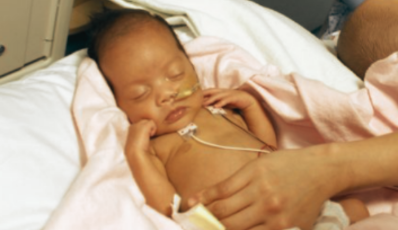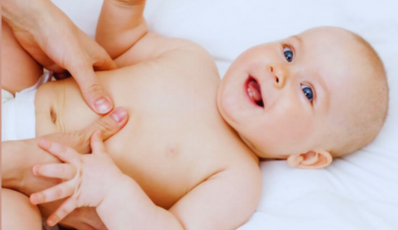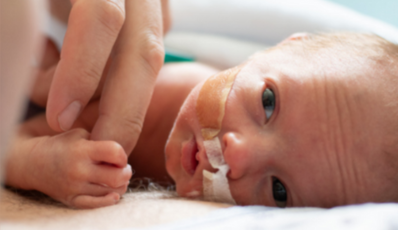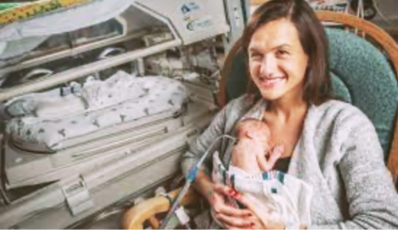Infant massage is a type of gentle massage that is provided to the infant via their carer (usually the mother), infant massage can involve rhythmic stroking of the baby’s body using various techniques with the intention to promote and assist in improving the child's health. Infant massage started in ancient times and many different cultural techniques have been brought together with research to understand the benefits and impact it can have on both infants and parents.
It involves different strokes and movements to the infant increasing vagal activity and lymphatic circulation benefiting the infant in many ways including weight, sleep, blood sugar levels, jaundice, pain relief. There are also many benefits for mothers if they are completing the massage. These benefits include but are not limited to helping release hormones in the mother, increasing bonding and reducing stress and anxiety. (IMIS, 2012)
Infant massage can be an amazing empowering way to assist with infants' health without using medications.
How does infant massage affect neonates in the special care nursery?
First of all we will talk about how infant massage increases weight gain in the Special care nursery infant.
What does the research say?
A nonrandomized clinical trial in a NICU level 3 hospital found an increase in weight gain for the very low birthweight infant of 1000g-1500g, which resulted in early discharge which in turn can reduce hospital cost (Diego, Field, Hernandez-Reif, 2005).
How does it do this?
A study completed by Diego, Field, Hernandez-Reif. 2005. Found that moderate-pressure massage in preterm infants increased vagal tone which in turn increases gastric motility resulting in increased weight gain.
What are the vagal nerves?
The vagal nerves play an important role in regulating a variety of bodily functions, including digestion. When the vagal tone is increased, it can stimulate the digestive system and improve absorption of nutrients, which can lead to weight gain in preterm infants (Diego, Field, Hernandez-Reif, 2005).

Preterm infant receiving baby massage
Regulates Blood Sugar Levels:
It was also found in another study that massaged preterm infants for 5 days along with increased weight gain also showed increased serum levels of insulin and IGF-1 levels (growth and development hormone). Helping infants regulate their blood sugar levels. This could be particularly important and I’m sure would be of interest for infants whose mothers are diabetic (Field, et al. 2008).
More alert neonates:
Massage of the preterm infant has also been linked with less time asleep after 5 days of massage and more time in a drowsy state of consciousness. This can be beneficial for preterm infants who may have difficulty waking up for feeds, as massage therapy can stimulate their wakefulness and promote more regular feeds, thus this can then contribute to increased weight gain (Field, Diego, Hernandez-Reif, 2010) .
Research also shows that infant massage can play a role in regulating sleep patterns in preterm infants, this includes the infant spending more time in active sleep and less time in deep sleep. Which can assist with overall arousal and increased wakeful periods (Field, Diego, Hernandez-Reif, 2010).
Jaundice:
Infant massage has also been discovered to assist with improvement in bilirubin levels. This is believed to be due to the increase in bowel movements excreting bilirubin. As infants who receive infant massage it stimulates the vagus nerve which stimulates the gastric emptying, thus exerting bilirubin and decreasing jaundice levels (Lin, Yang, Cheng, Yen, 2015)
Additionally, infant massage may also assist with overall relaxation and stress reduction in infants, which can assist with improvement in jaundice levels (Lin, Yang, Cheng, Yen, 2015).
Baby massage also assists neonates with medical interventions
Painful procedures can lead to long and short term complications in neonates.
A study conducted on neonates who required venipuncture found that neonates who received massage 2 minutes after the procedure had a significant reduction in pain scores. When baby massage and breastfeeding were combined there was an even further reduction in pain scores (Liu, Fang, Wang, Gao, Xin, Liu, 2022) .

Baby receiving touch therapy
Cost to hospitals
While massage is assisting neonates with all these amazing benefits it is also reducing costs for the special care nursery. In one study it stated it could allow neonates to be discharged up to sometimes 3 weeks earlier saving hospitals by 10,000 (USD) so nearly 15,000 AUD (Field, Diego, Hernandez-Reif, 2011) .
So how can you provide infant massage in the neonatal care unit?
While there is amazing evidence of how infant massage can assist infants in many ways. Infant massage is contraindicated for infants who have an open wound/burn, skin condition, recent surgery or certain medical conditions, as increased pressure and movement of these conditions could spread infection or further harm the infant (IMIS, 2012).
To ensure it is safe for the infant as all care including infant massage it should always be discussed with the paediatrician or health care provider to ensure the neonate or infant is stable enough to receive infant massage.
Parents should then be educated on the risks and benefits of baby massage, and should be involved in all decision making, as it is their child. Allowing parents to make decisions based on their beliefs is an important aspect of care while in the neonatal nursery, allowing parents to make informed decisions and trusting their intuition, setting them up with empowerment for when they take their child home.
Ways to assess if infants are safe to receive infant massage include:
- Health status
- Oxygen levels, heart rate, respiratory rate stable
- Behavioral responses- is the neonate comfortable when participating in confinement and kangaroo care.
Signs of readiness include:
- Unfolding fingers
- Flexed knees
- Dropped elbow and arms
- Relaxed feet and legs
- General relaxed body language
- Absence of stress signals.
If at any time the neonate or infant becomes stressed, massage should be stopped immediately.
Signs of mild stress include:
- Yawning
- Looking away
- Grimacing
- Having an uneasy tummy
- Sniffing
- Coughing
- Sticking the tongue out
- Dropping the jaw
- Closing the eyes while in an awake state
Moderate signs of stress:
- Sighing
- Splaying of fingers
- Crying
- Irritability
- Muscle tightening or jerky movements
Strong stress signals:
- Apnoea
- Decrease in oxygen levels
- Shallow breathing
- Heart rhythm quickening or slowing
- Blotches on skin
- Any signs of pain (crying, thrashing, arching back)

Parent touching their preterm neonate
Infant massage can be provided in many ways. As neonates and infants in the special care nursery usually don’t want to be stimulated it is important to ensure only one form of stimulus is introduced at a time, this is something important to discuss with the paediatrician (IMIS, 2012).
Touch is the first technique used for preterm infants, where a carer's hand is placed onto the neonate and not moved, allowing the neonate to become first of all comfortable with touch.
Once the neonate becomes used to this they may then move onto the next step (IMIS, 2012).
Confinement is the next step where the neonate is placed in the fetal position by the carer. Hands are brought to the chest and knees brought into the body. Holding the baby in this position can be comfortable for them, as this is the typical position while in utero, they feel safe while in this position (IMIS, 2012).
Confinement position
The skin-to-skin (kangaroo care) is the next technique used in neonates. This is where the neonate is placed on the carer’s bare chest. The neonate will have just a nappy on and a blanket will be placed over the neonate/ carer to avoid heat loss. Skin to skin has many benefits for both mother and infant, including but limited to regulating heart rate, temperature, and bloods sugar levels also assists with mothers hormones including increasing oxytocin which can assist with breastfeeding (Mrljak, Danielsson, Hedov, Garmy, 2022)

Preterm touch therapy containment technique
Once the infant has become comfortable with all these techniques infant massage can begin but should be introduced slowly (IMIS, 2012).
Indian stroking of the leg is the first stroke that should be used. This is where one hand is placed at the base of the leg and one around the ankle. With closed fingers begin to massage the leg massaging from the base of the leg to the ankle. Going with the hair, not against. This will then be followed by the incorporation stroke of the legs IMIS, 2012).
At the next session, add leg circles. With two or three fingers begin to massage in circular motions moving the skin and muscle. Then begin to warm up the abdomen, using light pressure in different sweeping motions. Avoiding the diaphragm is important as this can cause discomfort and pain for the infant. Do identify where the diaphragm is, find the base on the infants ribs then with your two index fingers draw a line inwards, above the line is the diaphragm, so avoid this area. Once a light warm up massage has been completed again follow it off by the incorporation stroke of the abdomen and legs this time (IMIS, 2012).
Session 3: You could then start to introduce Indian arm massage. This is similar to the leg massage. Have one hand with closed fingers at the base of the arm and the other hand at the wrist. Begin to massage with the hair swapping hands as it reaches the wrist. Once you have completed this on both arms again complete an incorporation stroke from the head to the legs but avoiding the chest. To do this go on either side of the body (IMIS, 2012).
Chest massage and swedish massage should not be introduced till the infant becomes used to all other strokes.
Infant massage also has many benefits for the parents involved too. For many parents they may feel unless and not feeling like they can do anything to help with their child's progression with health. Baby massage can be an amazing way for the parents to bond with their child and increase their sense of helping their child and making a positive impact on their child's progression. While this may be daunting at the start, parents can practice on a doll to become comfortable with the techniques before trying them on their child. Patience is key and be extremely considerate about their feelings and emotions (IMIS, 2012).
Postnatal depression is the most prevalent mood disorder associated with childbirth and can last for months affecting a family relationship. Infant massage can help with postnatal depression by decreasing cortisol levels and increasing oxytocin (Dehkordi, et al. 2019)

Preterm infant receiving skin to skin contact
How does baby massage assist the hospital/health care system?
As we have learnt about the many amazing benefits baby massage can help and assist with all this benefits including weight gain, reduced jaundice, maintaining bloods sugar levels, increased alertness for feeding and so on these can help with he progression on the infants health and well-being which in turn can lead to earlier discharges and reducing the cost to the healthcare system. In one study it stated it could allow neonates to be discharged up to sometimes 3 weeks earlier saving hospitals by 10,000 (USD) so nearly 15,000 AUD (Field, Diego, Hernandez-Reif, 2011). However, it is important to note that not all babies are candidates for infant massage and infant massage should only be taught to parents by certified Infant Massage Instructors.
End note:
Infant massage is an amazing tool that can benefit infants, mothers and the healthcare system in many ways as we have discussed above.
There are many ways other than medicine to assist infants in their progression to better health while also empowering the mother or parents of the child that they too are making an impact on their child's health.
Infant massage should only be taught to primary carers by an IMIS accredited Infant Massage Instructor to ensure correct technique is being taught.
References:
Dehkordi, et al 2019. Nursing and Midwifery Studies. The effects of infant massage on maternal postpartum depression: A randomized controlled trial. Doi:10.4103/nms.nms_80_17
Diego, Field, Hernandez-Reif. 2005. Pubmed. 10.1016/j.jpeds.2005.02.023. Retrieved 28/2/23 from https://pubmed.ncbi.nlm.nih.gov/16027695/
Dieter, et al. 2003. Pub Med. 0.1093/jpepsy/jsg030 Retrieved 28/2/23 from https://pubmed.ncbi.nlm.nih.gov/12904452/
Field T, Diego M, Hernandez-Reif M. Preterm infant massage therapy research: a review. Infant Behav Dev. 2010 Apr;33(2):115-24. doi: 10.1016/j.infbeh.2009.12.004. PMID: 20137814; PMCID: PMC2844909.
Field T, Diego M, Hernandez-Reif M, Dieter JN, Kumar AM, Schanberg S, Kuhn C. Insulin and insulin-like growth factor-1 increased in preterm neonates following massage therapy. J Dev Behav Pediatr. 2008 Dec;29(6):463-6. doi: 10.1097/DBP.0b013e3181856d3b. PMID: 18714203; PMCID: PMC2663361.
IMIS, 2023. Baby Massage. Discover the magic of baby massage. Retrieved 27/3/23. https://www.babymassage.net.au.
Liu J, Fang S, Wang Y, Gao L, Xin T, Liu Y. The effectiveness of massage interventions on procedural pain in neonates: A systematic review and meta-analysis. Medicine (Baltimore). 2022 Oct 14;101(41):e30939. doi: 10.1097/MD.0000000000030939. PMID: 36254036; PMCID: PMC9575769.
Lin CH, Yang HC, Cheng CS, Yen CE. Effects of infant massage on jaundiced neonates undergoing phototherapy. Ital J Pediatr. 2015 Nov 25;41:94. doi: 10.1186/s13052-015-0202-y. PMID: 26607061; PMCID: PMC4659198.
Mrljak, R.; Arnsteg Danielsson, A.; Hedov, G.; Garmy, P. Effects of Infant Massage: A Systematic Review. Int. J. Environ. Res. Public Health 2022, 19, 6378. https://doi.org/10.3390/ijerph 19116378
Rad,et al. 2016. Journal of clinical Neonatology. Retrieved 28/2/23 from https://jcnonweb.com/article.asp?issn=2249-4847;year=2016;volume=5;issue=2;spage=96;epage=99;aulast=Rad